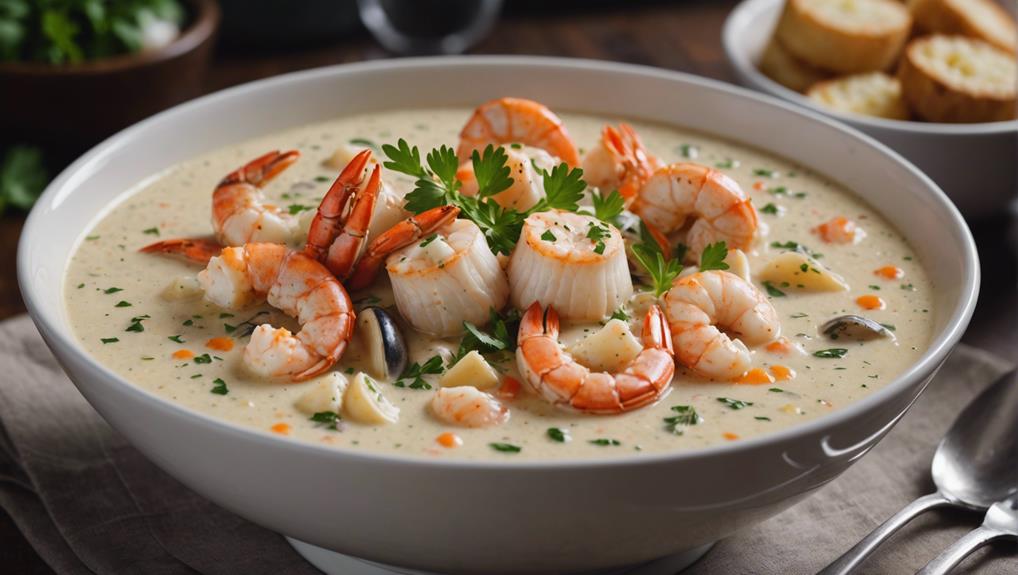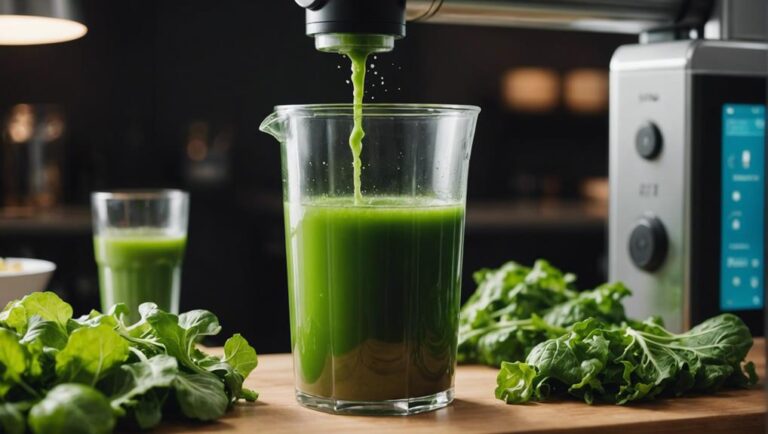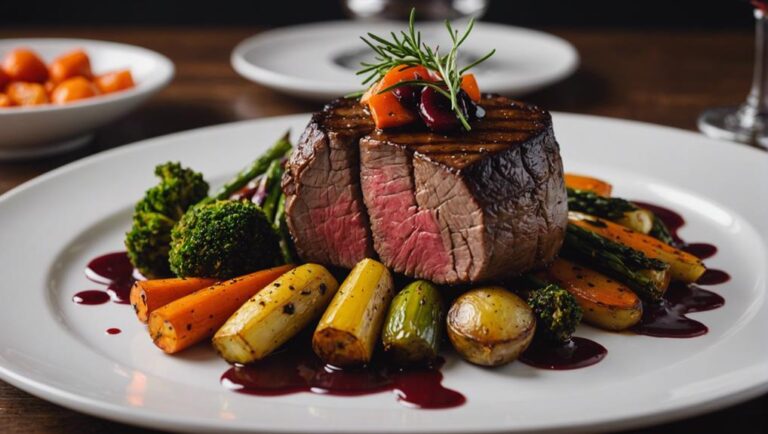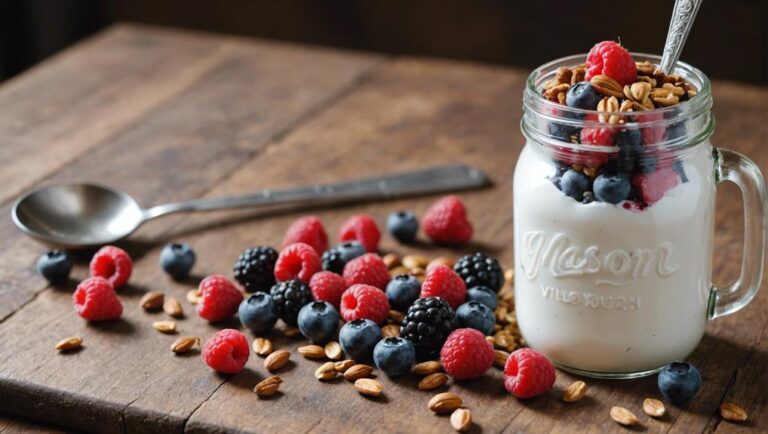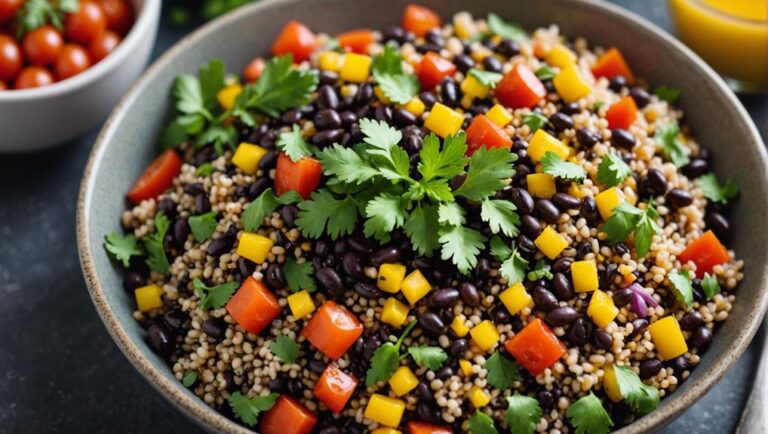Sous Vide Seafood Chowder
Immerse yourself in the luxury of sous vide seafood chowder, where flavors and textures harmonize to elevate this classic dish. Masterfully cooked ingredients, like scallops and shrimp, retain perfect textures, ensuring a culinary masterpiece. The infusion of fennel, white wine, and shallots adds layers of depth to the broth, creating a symphony of flavors. Customizable seafood options make this dish a standout for any occasion. Experience a whole new level of culinary excellence by savoring the ultimate fusion of flavors and textures with sous vide seafood chowder.
What You Will Learn Here
- Sous vide technique ensures precise temperature control for seafood perfection.
- Infusion of fennel, white wine, and shallots enhances chowder's depth.
- Customizable seafood selection allows versatility for different preferences.
- Luxury of sous vide elevates overall seafood chowder experience.
- Culinary masterpiece with optimal texture and flavor retention.
Chowder's Evolutionary Origin
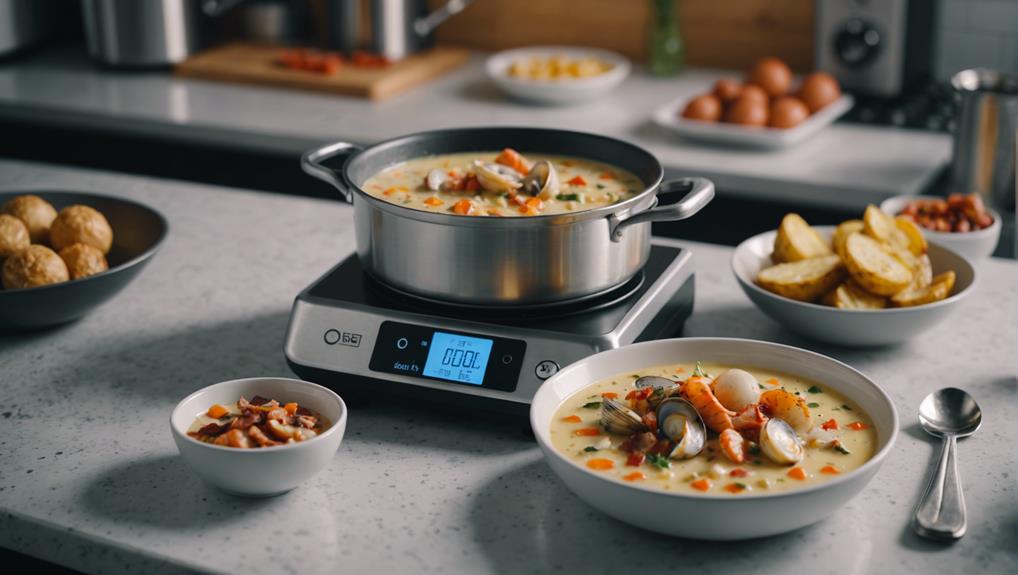
Consider the rich tapestry of chowder's history, tracing its roots back to coastal France and England in the 16th century.
Explore how this humble dish evolved from a simple blend of fish, potatoes, onions, and cream to a diverse array of seafood, vegetables, herbs, and spices.
Compare the regional nuances that have shaped the evolution of chowder recipes, reflecting the unique culinary traditions and ingredients of different locales.
Chowder History Timeline
The evolutionary origins of chowder can be traced back to the 16th century in Europe, where variations began to emerge in countries like England, France, and Spain.
The term 'chowder' is thought to have originated from the French word 'chaudière,' meaning cauldron, referencing the vessel used for cooking the dish.
Early chowders typically consisted of fish, seafood, or vegetables cooked in a broth or milk base, often with ingredients like potatoes and onions.
As time passed, American chowder recipes evolved, incorporating regional elements such as clams, corn, and salt pork, which contributed to the development of popular versions like New England clam chowder.
Chowder has since become a globally cherished comfort food, with contemporary interpretations showcasing a broad array of ingredients and culinary methods.
Ingredients Evolution Analysis
Tracing the historical roots of seafood chowder back to 16th century France reveals a culinary evolution influenced by French fish stews and soups. Seafood chowder has evolved over time to incorporate a wide variety of seafood selections and regional flavors. The table below highlights the key ingredients that have contributed to the evolution of this beloved dish:
| Evolutionary Ingredient | Impact on Chowder Evolution |
|---|---|
| French Fish Stews | Inspired the early versions of seafood chowder |
| Local Seafood | Incorporated coastal ingredients into chowder |
| Milk/Cream | Introduced from European culinary traditions |
| Various Seafood | Diversified chowder recipes over time |
| Regional Flavors | Added unique twists to traditional chowder recipes |
Regional Variations Comparison
Exploring the diverse regional variations of seafood chowder illuminates the rich tapestry of culinary influences shaping this beloved dish.
From the creamy New England clam chowder to the tomato-based Manhattan version and the clear broth Rhode Island recipe, each chowder reflects local ingredients and traditions.
Hatteras clam chowder adds tomatoes to the mix, while Delaware's variation opts for a milk-based broth. These adaptations highlight the evolving nature of chowder, adapting to local palates and resources.
Whether you prefer the heartiness of New England, the tanginess of Manhattan, or the simplicity of Rhode Island, each chowder recipe tells a story of culinary innovation and regional pride. Embrace the variety and savor the flavors of this timeless seafood soup.
Chowder's Flavorful Spice Blend
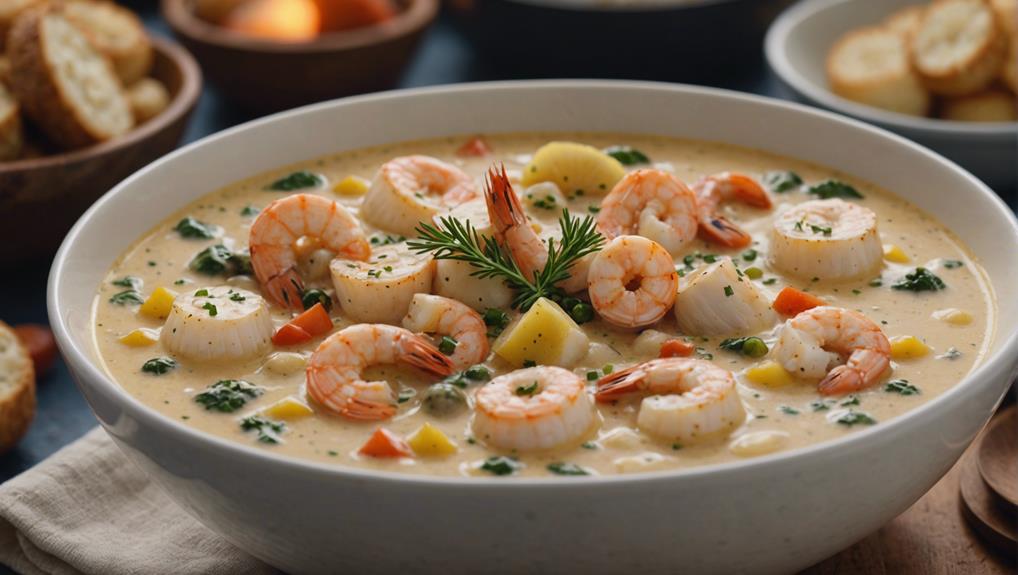
Enhancing the flavors of Sous Vide Seafood Chowder, the spice blend marries garlic, bay leaves, and black pepper to create a rich and aromatic base. When preparing this delightful chowder, consider the following to make the most out of its flavorful spice blend:
- Garlic: Infusing the chowder with a subtle yet distinct aroma, garlic adds depth to the overall flavor profile.
- Bay Leaves: These leaves bring a herbal nuance to the chowder, enhancing the seafood notes with their earthy undertones.
- Black Pepper: Providing a hint of warmth and a touch of heat, black pepper elevates the chowder's taste without overwhelming the delicate seafood flavors.
- Balanced Combination: The key to a successful spice blend lies in the harmonious balance of these ingredients, ensuring that they work together to enhance, not overpower, the essence of the Sous Vide Seafood Chowder.
Seafood Chowder Variations
Explore the world of seafood chowder variations with lobster bisque, clams casino, and sous vide crab legs. Elevate your chowder game by trying out these gourmet recipes that showcase the richness of lobster, the brininess of clams, and the succulence of crab.
Indulge in these flavorful variations to take your seafood chowder experience to the next level.
Lobster Bisque Recipe
To elevate your culinary skills and impress your guests, consider mastering the art of creating a velvety lobster bisque that encapsulates the essence of luxury seafood dining.
When making lobster bisque, follow these steps for a divine dining experience:
- Begin with Quality Ingredients: Select fresh lobster and use the shells to extract maximum flavor.
- Utilize Sous Vide Cooking: Showcase the versatility of sous vide for tender and flavorful lobster meat.
- Attention to Detail: Guarantee precision in cooking techniques to achieve a rich seafood essence.
- Decadent Presentation: Serve the creamy bisque under a puff pastry dome for an elegant touch.
Clams Casino Recipe
Elevate your seafood repertoire with a tantalizing Clams Casino recipe that adds a flavorful twist to traditional seafood chowder variations. Clams Casino is a classic seafood dish that originated in Rhode Island and is beloved for its delicious combination of clams, bacon, breadcrumbs, and seasonings.
Here's how you can enjoy this delectable dish at home:
- Prepare the Clams: Shuck fresh clams and place them on a baking sheet.
- Top with Goodness: Add a mixture of crispy bacon, breadcrumbs, and your favorite seasonings on each clam.
- Bake or Broil: Cook the clams until the bacon is crispy and the clams are tender.
- Serve and Enjoy: Delight your taste buds with this savory appetizer that's perfect for any seafood lover.
Sous Vide Crab Legs
Immerse your crab legs in a precise sous vide bath to reveal their sweet and delicate flavors, enhancing your seafood chowder experience. When preparing sous vide crab legs, follow these steps to achieve perfection:
- Seal the crab legs in a vacuum bag with a pat of butter and a sprinkle of seasoning for enhanced flavor.
- Set the sous vide water bath to 135°F (57°C) for 45 minutes to guarantee the crab legs are cooked to perfection.
- Once cooked, remove the crab legs from the bag and gently crack them open to reveal the succulent meat inside.
- Add the sous vide crab legs to your seafood chowder just before serving to elevate the dish with luxurious flavors and textures.
Chowder Texture Enhancement
Enhancing the texture of your chowder involves focusing on creaminess and thickness, perfecting flavor infusion techniques, and creating a contrast in ingredient textures.
By carefully balancing these elements, you can elevate the overall experience of your seafood chowder.
Experimenting with these key points will help you achieve a harmonious blend of flavors and textures in your dish.
Creaminess and Thickness
For a lusciously thick and creamy seafood chowder, consider utilizing heavy cream or half-and-half to achieve a rich texture. To further enhance the creaminess and thickness of your chowder, incorporating a roux made from butter and flour can provide a velvety consistency. Pureed vegetables such as potatoes or corn can also contribute to a heartier texture, while a cornstarch slurry serves as an effective thickening agent. Additionally, simmering the chowder on low heat allows flavors to meld and the soup to naturally thicken over time.
| Creaminess Enhancers | Description | Benefits |
|---|---|---|
| Heavy Cream | Rich and indulgent addition | Adds a creamy texture |
| Roux | Butter and flour mixture | Thickens and provides a velvety consistency |
| Pureed Vegetables | Potatoes or corn | Adds thickness and heartiness |
| Cornstarch Slurry | Cornstarch and water mix | Effective thickening agent |
| Simmering | Low heat for extended time | Melds flavors and natural thickening |
Flavor Infusion Techniques
To elevate the essence of your seafood chowder, infuse it with aromatic garlic, shallots, and fennel for a tantalizing taste experience. When cooking sous vide, seal the ingredients in airtight bags, allowing them to cook gently in their natural juices, ensuring peak texture and flavor retention.
This method enhances the seafood's natural taste, infusing it with the essence of the aromatics. Additionally, incorporating white wine into the sous vide bag adds acidity and depth to the broth. Utilize bay leaves during the sous vide process to impart a subtle herbal note to the chowder.
Season with salt and pepper at the right stages to perfectly balance and enhance the overall flavor profile of your chowder.
Ingredient Texture Contrast
Elevate the sophistication of your seafood chowder by mastering the art of ingredient texture contrast through precise sous vide cooking techniques. Sous vide cooking enables you to control the texture of each ingredient perfectly, ensuring a delightful experience with every bite. By cooking seafood separately at specific temperatures, you achieve optimal texture variations in your chowder. For instance, tender and buttery scallops paired with firm and juicy shrimp create a harmonious blend of textures. This method allows each seafood component to retain its unique texture and flavor profile, enhancing the overall dining experience. Dive into the world of sous vide and transform your seafood chowder into a dish that delights the senses.
| Seafood | Texture | Sous Vide Temperature |
|---|---|---|
| Scallops | Tender, Buttery | 122°F |
| Shrimp | Firm, Juicy | 136°F |
| Salmon | Flaky, Moist | 126°F |
| Cod | Flakey, Tender | 130°F |
Final Thoughts
In conclusion, contemplate the harmonious blend of flavors and textures in this Sous Vide Seafood Chowder, a culinary masterpiece that guarantees a delightful dining experience. The sous vide method employed in this recipe guarantees that the seafood components are cooked to perfection, resulting in a tender, juicy, and flavorsome outcome. By infusing elements like fennel, white wine, and shallots, this chowder offers a depth of flavor that's both comforting and satisfying.
The beauty of this seafood chowder lies in its simplicity and versatility. The ease of preparation coupled with the option to customize the seafood selection according to your preferences makes it a go-to dish for various occasions. Whether you're a seafood enthusiast or a culinary adventurer, this chowder promises a sensory journey that will leave you craving more. Embrace the luxury of sous vide cooking and treat yourself to a bowl of this delectable seafood chowder for a truly memorable dining experience.
Frequently Asked Questions
What Temperature Do You Sous Vide Seafood?
When you sous vide seafood, aim for 120-140°F for tenderness. Different seafood may need varying temps and times. Sous vide gives precise control, preventing overcooking. Lower temps retain moisture for delicate flavors. You'll enjoy perfectly cooked seafood.
Can You Make Seafood Chowder the Day Before?
You can absolutely make seafood chowder the day before. It allows flavors to meld, intensify, and the chowder to thicken. Preparing in advance saves time and enhances taste. So go ahead, plan ahead for a delicious seafood chowder experience!
What Can I Use to Thicken Seafood Chowder?
You can thicken seafood chowder effectively with a cornstarch slurry or a roux. The cornstarch slurry, made by mixing cornstarch with cold water, or a roux, a blend of flour and fat, will give your chowder a rich and creamy consistency.
What Is the Difference Between Clam Chowder and Seafood Chowder?
In seafood chowder, a variety of seafood like shrimp and scallops are used, offering a diverse flavor compared to clam chowder. Clam chowder focuses on clams, while seafood chowder gives a richer taste with a mix of seafood.
Conclusion
Indulge in the rich and velvety flavors of sous vide seafood chowder, a dish that beautifully combines the essence of the sea with the comfort of a warm bowl of soup.
Explore the endless possibilities of this classic dish by experimenting with different seafood variations and texture enhancements.
Elevate your culinary skills and impress your guests with this innovative and sophisticated twist on a traditional favorite.
Bon appétit!
